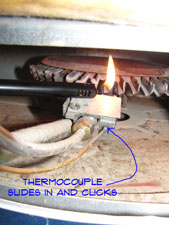 Installing a water heater thermocouple involves two steps. First you need to remove the thermocouple and Second you have to install the new one.
Installing a water heater thermocouple involves two steps. First you need to remove the thermocouple and Second you have to install the new one.
Not sure if this is your problem? See the article 'Troubleshooting Gas Water Heater Problems' for a complete listing and discussion of issues and the solutions.
Purchasing a Thermocouple
Before you begin, you should purchase a replacement thermocouple.You can buy generic thermocouples that will work on most gas water heaters. However, they cannot be cut, so you want to get one that is close to the length of the one you have.
See the article 'Purchasing a Water Heater Thermocouple' for information on what you need to watch out for when buying this part.
Removing the Old Thermocouple
Before you start, turn the dial on the gas valve to off. Then turn the gas valve at the gas line to off. Turn it so that it is perpendicular to the pipe.
The thermocouple is attached to the water heater at two locations. The first location is at the underside of the gas valve. The thermocouple looks like a bare copper wire with a fitting on the end. You will need an open end wrench or an adjustable wrench to loosen the fitting.
You will have a cover plate that has to be removed to see the other end of the thermocouple. The outer cover place usually just snaps into slots on the sides of the opening. Squeeze the cover plate to get the tabs out of the slots.
There may be another cover plate with a small window in it that will also need to be removed. This one will have some screws that need to be removed.
Once you have the inner plate removed you should be able to follow the thermocouple to the clip that holds the pilot light. If you can get to it effectively, there may be a retaining clip that holds the thermocouple in place. If there is, use a screwdriver to release the clip and pull the end of the thermocouple out.
If you cannot pull the thermocouple out, you will need to remove the entire burner assembly. This sounds harder than it is. See the article 'Removing a Gas Water Heater Burner Assembly' for instructions on what to do.
Installing the New Thermocouple
Use the old thermocouple as a guide for bending the new one. Use a tubing bender and try to avoid kinking it. When you are satisfied with the configuration you can insert the thermocouple into the retainer at the pilot light assembly. It should seat firmly into place. A click or snap is a good sign that is seated properly.
Put the burner assembly back into the chamber. If there is an alignment clip or seat make sure you get it back in the proper spot. Hook up the gas pipe, pilot light pipe and thermocouple to the gas valve. Make sure the fittings are tight.
Depending on the style of hot water heater that you have you may want to light the pilot light at this point. Your water heater should have a set of instructions on it for lighting the pilot light. Follow those instructions. Generally, you want to turn the gas valve to off. Then turn the gas back on. Have a long barbecue lighter ready and then turn the gas valve to pilot. Light the pilot with the lighter.
See the article 'How To Light a Water Heater Pilot Light' for additional instructions. Pilot lights can be a little fickle. When you don't get them lit in time the gas valve will shut off. Then you have a waiting period before you can try again.
For a water heater that has an igniter, you will want to replace the chamber cover and screw it in place. Follow the instructions on your unit to light the pilot. See the article 'Using an Igniter to Light a Water Heater' for instructions on using this type of system.
With the pilot lit you want to replace any covers that are still off. Turn the gas valve to on and the burner should fire up.
Summary
Replacing a gas water heater thermocouple is not too big of a job. Getting the right one was probably the worst part. Actually it was not that bad, they have generic ones that fit most water heaters. Unhooking the fittings getting the burner assembly free was most of the rest of the work.
We hope that you were successful with this project. More importantly, we hope everyone is able to take showers, bath's or do laundry as desired. Will you continue in your home repair career? We hope so.

